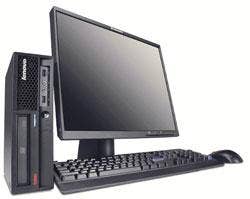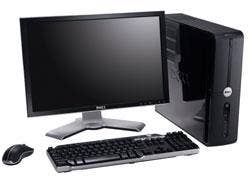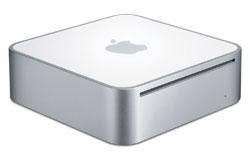Bake-Off: Desktop PCs With Value
OEMs have stepped up to the plate with a broad variety of form factors, architectures, functions and performance capabilities—in many cases putting a full-court press on very specific segments of the overall PC market, such as SMB. Driven by advances in processing, pricing in memory and storage, and improvements in thermals and energy efficiency, PC makers have provided the channel with a lot of innovation so far in 2008.
This month, the Test Center took a look at systems on the market from several manufacturers—measuring them against an in-house system made with industry-standard components—with a specific focus on the sweet spot of the desktop space for business: midlevel, basic desktops that could as easily be deployed in large environments as in small businesses.
We invited several Tier 1 OEMs to participate in this comparative review, asking them to provide systems with Intel Core 2 Duo CPUs at no greater than 2.53-GHz clock speed, up to 4 GB of RAM, and on-board graphics with Windows Vista Business. Lenovo, Dell and Acer America Inc. provided desktops that met those criteria; we also decided to include a low-end Mac mini desktop for a variety of reasons we'll explain.
Hewlett-Packard Co., the industry's No. 1 PC maker in terms of market share, initially told us it would participate in a comparative review. However, on deadline, an HP spokesman informed us that the company was dropping out, explaining that HP is in the midst of a product transition and wasn't able to provide a new system for our review.
HP would have had tough competition. We found a lot to like about the Lenovo ThinkCentre M57, the Dell Vostro V220 (to our surprise) and the Mac Mini (even though it had a much slower processor and less memory than the others).
Acer America did provide two desktops for review—desktops that we liked and recommend—but they fell outside the specifications we asked for so were not included in this piece. (The Acer units have been reviewed in separate pieces on ChannelWeb.com.)
Our methodology is straightforward: We examined each desktop for performance using Primate Labs' Geekbench benchmarking software; power consumption; heat generation; noise; form factor and pricing. We considered functions, management capabilities and price, as well as each vendor's channel program. We also considered value-add compared to the base, in-house, no-frills system we built in the Test Center lab.
After lining them up, the Test Center has given top honors to the Lenovo ThinkCentre M57—which provided a combination of features, performance and design that is keeping itself slightly ahead of the pack in a highly competitive space. After that, we found the Vostro V220 a solid second place, then Apple's Mac mini. We can recommend each of them to solution providers who are delivering desktops to businesses.
For a baseline comparison, we first decided to build our own white-box desktop using standard components in the lab with similar specifications to the other contenders. On an Asus P5Q3 Deluxe motherboard, we used an Intel Core 2 Duo E7200 at 2.53 GHz, Kingston HyperX DDR3 memory, and a 350-watt Antec Basiq power supply. Since the motherboard does not have integrated video, we also installed an ATI HD 3470 graphics card. With Windows Vista Business installed and patched with the latest updates, we tested the system to see how it would stack up.
The P5Q3 is the latest generation of Asus' motherboards that uses multiple energy-saving features, including a software utility called AI Gear. Essentially a user-friendly GUI to adjust the clock speeds of various components, AI Gear lets the user balance performance needs with power usage. Since the feature was available to us, reviewers duplicated the tests multiple times to see how much of a difference the various settings made.
We decided to stay on Turbo Mode for power management. On this setting, power usage was 75 watts when idle and 87 watts under load, with a GeekBench2 score of 3029.
Next: Lenovo ThinkCentre M57 Ultra Small Desktop LENOVO'S THINKCENTRE M57 ULTRA SMALL DESKTOP
The M57 came to us with an Intel Core 2 Duo e4600 vPro CPU at 2.4 GHz, 2 GB of RAM, built with the Intel Q35 Express chipset. It was loaded with Windows Vista Business and came with a 150-GB hard drive. It's priced at $846, putting it in the mid-to-upper range of desktop pricing in this performance range.

On Geekbench, it rang up a score of 2514. The M57 consumed 42 watts of power during a normal workload. The 76 degrees of heat it threw (at its vent) were only a couple of degrees warmer than room temperature, and we remain impressed by the thermal engineering Lenovo has shown all year in both its desktops and notebooks.
The M57 did, however, produce a slight hum—not enough to register 50 db but enough to notice in a silent room. That was only one of two areas where the desktop lost points. (We recommend 4 GB for PCs that run Windows Vista.) In the end, though, those were minor issues.
We loved, however, the M57's form factor. Built at 10 1/2 inches by 9 inches by 3 inches, the desktop uses a ridiculously small footprint for its class; it's also built so that the LCD can easily fit on top of it. Lenovo has also been mounting strong efforts to keep its systems eco-friendly. Here, too, it succeeds.
The M57 would fit well in a variety of different deployments, including retail locations, where it would be in eyeshot and earshot of customers (think insurance agencies or public libraries, for example); or where space is at a premium.
We feel with the M57 Ultra Small Desktop, Lenovo provides leading value for a business desktop and it takes first place in this comparative review.
Next: Dell Vostro V220 DELL'S VOSTRO V220
Dell introduced its Vostro lineup of desktops and notebooks last year, in what was then a new brand aimed at delivering small-business-focused solutions heavy on management and ease of use. Earlier this year, the Test Center looked at the Vostro 200 Slim PC—a desktop we liked for its combination of performance, form factor and pricing. The Vostro V220—which at deadline hadn't been officially launched but was set for availability by month's end—isn't a slim form factor, but it does follow up with decent performance, a configuration we liked, and nice, out-of-the-box ease of installation and use.

The V220 came with an Intel Core 2 Duo E7200 CPU at 2.53 GHz and 4 GB of RAM. Testing with Geekbench, the PC scored 2776—less than the Vostro 200 but higher than the other business desktops we took up for this review. Running a standard workload, the V220 drew 64 watts of power and threw 79 degrees at its vent. Its noise level was below the ambient sound in the lab and our decibel meter's threshold of 50.
While most of Dell's business is still direct, it may want to make less prominent an icon that allows for customers to contact Dell directly for support and other issues.
Aside from what it did provide on the V220, Dell also got our attention with what it did not provide: namely, bloatware. Save for McAfee security software and a Google search widget, the PC was refreshingly free of bloatware. Combined with its strong performance numbers, its 4 GB of RAM and its clean design, we have no problem recommending the Vostro V220 for VARs—although it won't get the blue ribbon until it can promote VAR services and support as it does for its own.
Next: The Mac Mini THE MAC MINI
For years, it's been difficult to do "apples to apples" comparisons between Macs and PCs in performance testing. Either different CPU platforms, incompatible benchmarking software or the sweepingly different operating systems made it impossible to get a fair read on how one system did against another.

At the last minute, however, we decided to include a low-end Mac mini for laughs and giggles. For one thing, Macs now are standardized on Intel's Core 2 Duo platform. For another, virtualization software makes it possible to run both Mac OS X and Windows Vista on the same box. And, last, over the past year we've become incredibly impressed with the cross-platform nature of Primate Labs' Geekbench benchmarking software to fairly gauge hardware performance regardless of operating system.
With that in mind, we tested a low-end Mac mini the Test Center acquired earlier this year. The system was built with an Intel Core 2 Duo T5600 at 1.83 GHz and a meager 1 GB of RAM, preloaded with Mac OS X 10.5. Still, it delivered a Geekbench score of 2368—essentially the same ballpark in performance as the ThinkCentre M57 and the Vostro V220. Its heat generation never wandered above room temperature and its noise never rose above the ambient level of the room.
But wait, as they say, there's more.
Using Parallels' virtualization software, we loaded Windows Vista Business onto a VM and again used Geekbench. While the score was a relatively low 1468, nobody buys a Mac to run Windows Vista as its primary OS. It's an add-on. Including the cost of a Windows Vista license, the configuration ran about $800. The Mac mini gets points for providing nice value in a tiny form factor, and in giving VARs and their customers the flexibility to deploy Mac OS systems and Windows in the same box.
For those dyed-in-the-wool Mac lovers out there, we know, we know: We could have used a higher-performing system that would have done better on a raw-score basis. But that's not the point. We know that if we had chosen a Mac with more horsepower, the performance numbers would have been better. But we can now say, in an apples-to-apples review, the Test Center can recommend the Mac mini in business cases.
BOTTOM LINE:
We weren't surprised that Lenovo won this review with its ThinkCentre M57; the Raleigh, N.C.-based PC maker has been impressive all year in this area and the M57 scores well with its combination of price, performance and design. We were surprised, though, with the continued pressure Dell is applying in the SMB arena with its Vostro V220, which is good, as well as how Apple's platform now competes in price, performance and features with the PC guys—even running Windows. We believe HP, which has been slow in refreshing its desktop line this year, will face a bigger threat going into 2009 in a world where innovation is often a key indicator of strength.